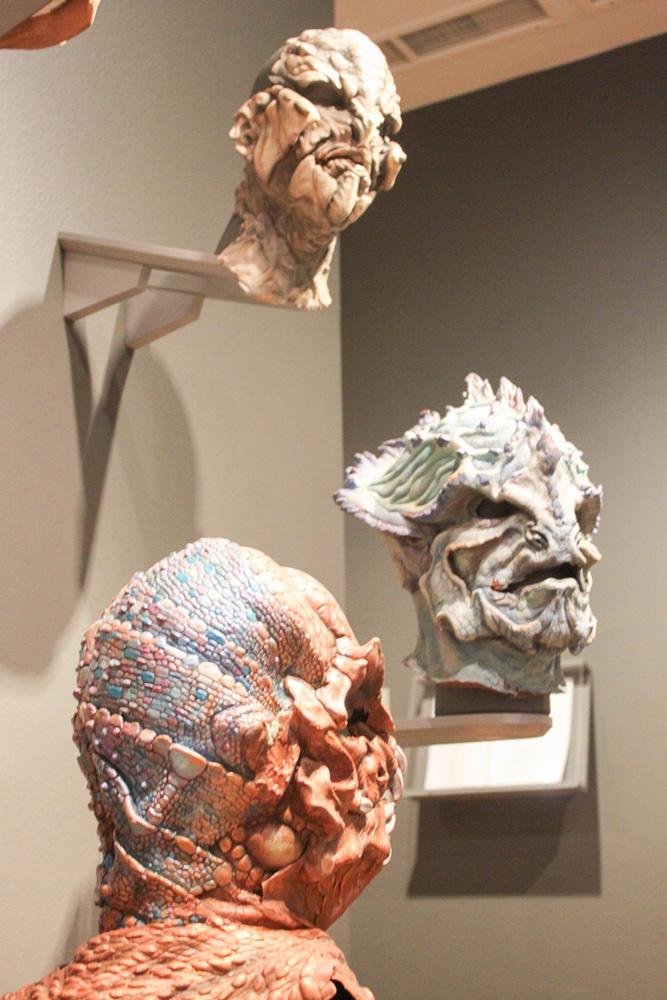
Rebecca Lauffenburger
For the next few months, entering the Art, Design and Architecture Museum is sure to be a bit disorienting. Chairs flipped upside down or turned on their side hang suspended from the walls and ceiling, while dead-ahead, incredibly lifelike masks of strange creatures greet all who walk through the museum’s doors.
Once again, the Art, Design and Architecture Museum has brought culture and beauty to our campus. The museum opened its doors Sep. 10, welcoming University of California, Santa Barbara students and community members alike to enjoy Done. Undone. Redone. The Chair.; Irving J. Gill: Simplicity and Reform; and LIFEFORMS: The Makeup Art of Michael Westmore. Each exhibit, whether through chairs or alien creatures, captures in essence what it means to be human.
Leave your preconceived notions at the door: Done. Undone. Redone. The Chair., one of their newest exhibitions, is much more than just a collection of cool-looking chairs. Each piece on display is unconventional in some aspect. What is fascinating about the exhibit isn’t so much the object itself, as it is the context of the object. From an ornate green velvet throne resting on a pillar in the middle of the space to a multi-plywood piece designed and painted in a style reminiscent of the the bold De Stijl period, each chair tells more about the humanity’s evolving needs, demands and aesthetics. It forces the viewer to observe a rather commonplace fixture in an entirely new perspective as something innovative, artistic and representative of different societal ideals.
“When you have the Bauhaus type of chair up here on the wall…it’s where I think things are really going right now,” Michael Seiler, an Ohio collaborative artist who visited the museum along with his wife Kathy, commented at the exhibit.
The museum’s collection of architect and artist Irving J. Gill’s floor plans, models, photographs, paintings and sketches are an eye-opening testament to the beauty and artistry behind steel and concrete. The exhibit presents architecture as more than just a finished product; it explores the kind of thought and scrutiny that went into creating some of Southern California’s most iconic architecture. In juxtaposition to some of the more extravagant pieces found in Done. Undone. Redone. The Chair., Simplicity and Reform features buildings that manage to be both unassuming and striking, through Gill’s use of what he himself described as “the straight line, the cube, the arch, and the circle.”
As a conscientious artist, Gill aimed to design buildings with those they would serve in mind. He considered not only the aesthetics of his buildings, such as how to let in the most amount of natural light, but also sanitation, safety and cost of material. Gill aimed to create housing that was as efficient as possible in terms of resources consumed, in order to fill the need for more affordable housing for the working class during the 1900s.
Seiler went on to add that it was “thrilling to see [Irving J. Gill’s] work… This is really nice stuff, I can see, I can see y’know like the Louis Sullivan thing, the Morris and the Frank Lloyd Wright influences; it’s exciting”.
Perhaps the most sensational and anticipated event, LIFEFORMS: The Makeup Art of Michael Westmore showcases the UCSB alumnus’s work on the iconic science fiction series Star Trek. At the forefront of the exhibit are numerous masks of the series’ most imaginative creatures, among them Data, Worf and the Ferengi and Vorg species. In addition to being able to view the physical result of Westmore’s ingenuity, one can see the the transformative process of makeup art and prosthetics through both a television mounted on the wall and a series of photographs. Through the numerous masks, prosthetics and sketches lining the walls, LIFEFORMS explores the creative process that brought a cultural phenomenon to life.
Each exhibit, worldly or otherworldly, examines the artistry behind both the commonplace fixtures of our world and culture, and the imaginations of a generation. Each is, in its own way, a testament to the innovation and creativity of the human spirit, and the type of artistic genius that pushes our society forward through everything from more affordable homes to pop culture.










